

Venus is not an easy object to image. It is very bright, generally low in the sky, and shows no surface details because it is covered in clouds. Its main feature of interest is that it shows phases like the Moon, one of only two planets to do so to any significant degree. The pictures below were taken during 2004 before, during, and after the transit on 8th June, and show the changing phase and size of its appearance as it approached and then receded from the Sun in the sky.
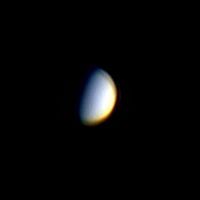 |
This picture was taken at 1832 UT on 1st March 2004 and shows Venus half illuminated. Venus was 137 million kilometres (0.919 AU) from the Earth and subtended an angle of 18 seconds of arc. | ||
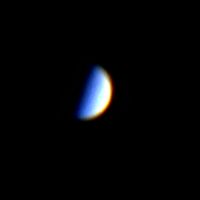 |
This picture was taken at 1957 UT on 19th March 2004. The change in phase over the 18 days between the pictures is evident. Venus was 107 million kilometres (0.718 AU) from the Earth and subtended an angle of 21 seconds of arc. | ||
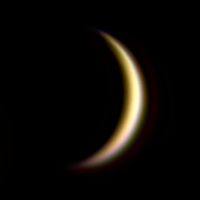 |
This was the last image I took of Venus prior to its transit. It was taken on 21st May 2004, just 18 days before the transit. Conditions were difficult, Venus was low in the sky at 10 degrees so atmospheric dispersion was quite bad. However Registax helped me realign the colours rather successfully. Venus was 49.7 million kilometres (0.332 AU) from the Earth and subtended an angle of 50 seconds of arc. | ||
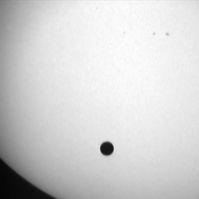 |
On 8th June 2004 there was a transit of Venus across the face of the Sun. These
are very rare occurrences, the last was on 6th December 1882 and the first that could be seen
in its entirety from the United Kingdom since 23rd May 1283, so I was very fortunate to have clear skies.
(The next one visible in its entirety from the UK will be on 11th June 2247.) The next transit will be
in 2012, starting at about 22:12 UT on 5th June. After that we will have to wait until 11th December 2117. Clicking on the image to the left will download a 170K montage of 16 images taken during the transit. Venus was now only 43.2 million kilometres (0.289 AU) from the Earth and subtended an angle of 58 seconds of arc. |
||
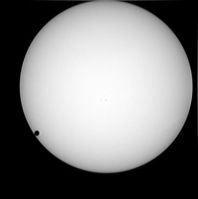 |
Transit of Venus 8th June 2004, 2nd Contact. Second contact is the moment that the trailing edge of Venus is in contact with the limb of the Sun.
I timed this from a video at higher magnification as 05 38 38 UT. Click on the image to see a larger version. |
||
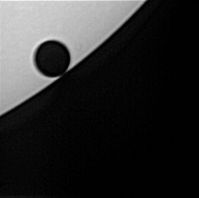 |
Transit of Venus 8th June 2004, 3rd Contact. This is from the higher-magnification video of Venus as it began to move off the Sun (Click on the image to see the original). 3rd contact is the
moment that the leading edge of Venus is in contact with the limb of the Sun. By looking at individual frames of this video I was able to time this event as 11 04 34 UT. I submitted these and similar timings of 1st and 4th contacts to vt2004 who calculated my value of the Astronomical Unit. My mean value was 149,556,449 Km which is only 41,421 Km short of the official value; an error of 0.028%. |
||
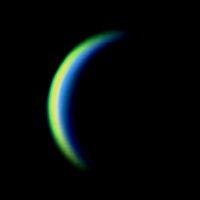 |
This picture of Venus was taken on 3rd July 2004, which is 25 days after the transit. It was by then a morning object and so illuminated from the other side. Unfortunately I forgot to put my
X2 lens on the telescope, so this was taken at prime focus of the ETX125. To make the pictures here comparable, I have enlarged
this one by a factor of 2, so the quality is not so good. For some reason the colours were such that I could not align them
completely as I did with the image just prior to the transit. The reason can be seen here
where you can see the three colour images that make up the whole. For some reason the red image is much sharper than the other
two colours. Click here to see an image taken in the infra red. Venus was receding again and was 55.6 million kilometres (0.372 AU) from the Earth and subtended an angle of 45 seconds of arc. |
||
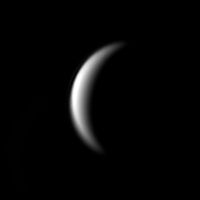 |
The morning of the 5th July was clear and still, so I was able to get better pictures of Venus, this time using my X2 lens. Click
here to see a composite of images from that morning. These include two pictures taken in infra-red
light but with the camera set to colour (normally I set it to B/W for my IR pictures). Also included are pictures taken
at high and low gamma settings to illustrate the effect of the setting of gamma. A low gamma increases the contrast between the planet
and the bright sky. Venus was 57.3 million kilometres (0.383 AU) from the Earth and subtended an angle of 44 seconds of arc. |
||
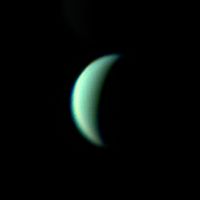 |
Venus on the morning of 19th July 2004 at 03:15UT. This is 50 mins before sunrise so the sky was getting quite bright.
However Venus was at its brightest only four days before and was still at magnitude -3.5. Venus was 71.5 million kilometres (0.478 AU) from the Earth and subtended an angle of 35 seconds of arc. |
||
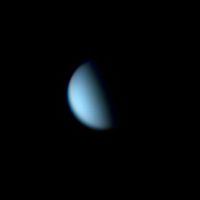 |
Venus on the morning of 6th September 2004 at 04:03UT. Although receding from the Earth it was still
a brilliant morning star at magnitude -3.9 Venus was 128 million kilometres (0.857 AU) from the Earth and subtended an angle of 19 seconds of arc. |
||
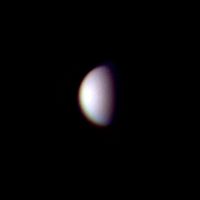 |
Venus on the morning of 19th September 2004 at 04:41UT. Although somewhat further from the Earth and
smaller in the sky, it had dimmed imperceptibly since the last picture. Venus was 143 million kilometres (0.954 AU) from the Earth and subtended an angle of 17 seconds of arc. |
||